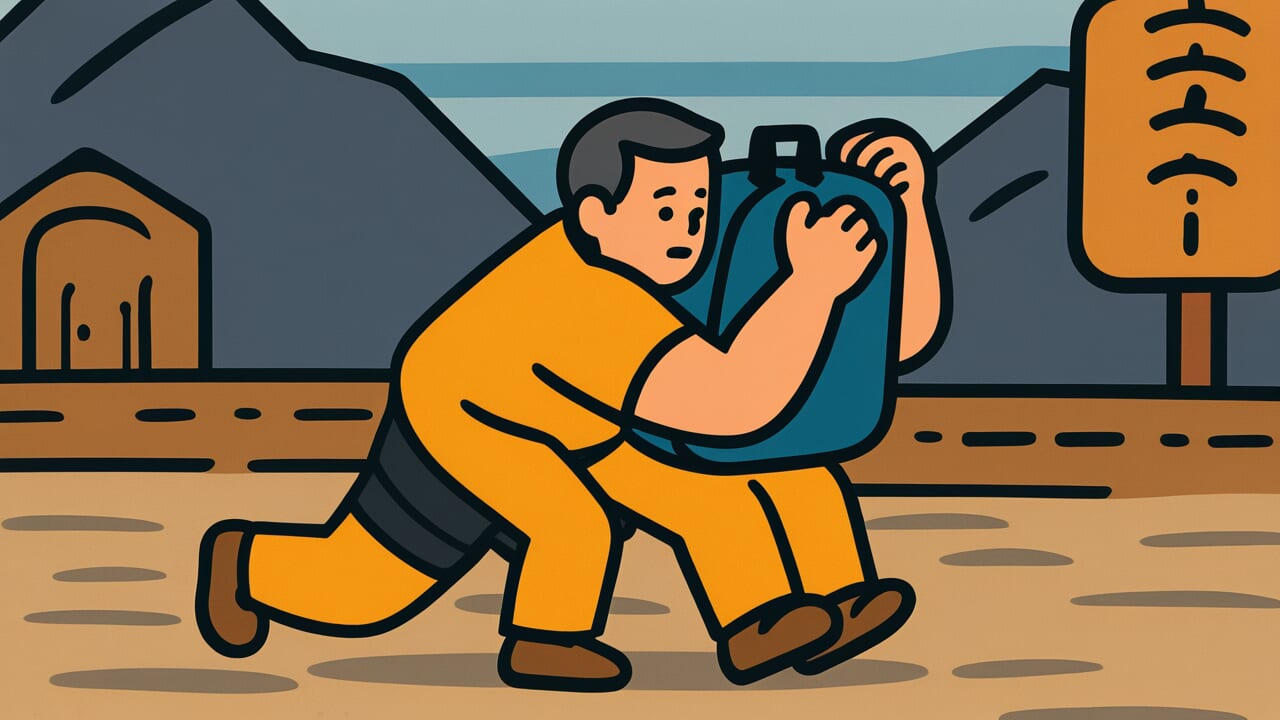How to Read “A man may bear till his back breaks”
A man may bear till his back breaks
[uh MAN may BEAR till hiz BAK brakes]
The word “bear” here means “carry” or “endure,” not the animal.
Meaning of “A man may bear till his back breaks”
Simply put, this proverb means that everyone has a breaking point when dealing with hardship or stress.
The literal words paint a picture of someone carrying heavy loads. They keep adding weight until their back finally gives out. The deeper message is about human endurance and limits. We all can handle problems, work, and difficulties up to a certain point.
We use this saying when someone seems overwhelmed by life’s demands. It applies to students juggling too many activities. It fits workers taking on extra shifts without rest. It describes anyone dealing with family problems, money troubles, and health issues all at once.
What’s interesting about this wisdom is how it reminds us that strength isn’t unlimited. People often think they should handle everything thrown at them. This proverb suggests that recognizing limits is actually wise. It’s not about being weak but about being realistic.
Origin and Etymology
The exact origin of this proverb is unknown, though it appears in various forms in English literature from several centuries ago. Early versions focused on the physical image of carrying burdens until collapse. The saying likely emerged from observations of laborers and pack animals.
During earlier centuries, people regularly witnessed the physical limits of human endurance. Manual labor dominated daily life. Workers carried heavy loads, farmers hauled grain, and travelers bore their possessions on their backs. The connection between physical and emotional burdens felt natural.
The proverb spread through oral tradition and written collections of folk wisdom. Over time, it evolved from describing literal back-breaking work to emotional and mental stress. Modern usage focuses more on psychological limits than physical ones. The core message about human limitations remained constant throughout these changes.
Interesting Facts
The word “bear” in this context comes from Old English “beran,” meaning to carry or support. This same root gives us words like “burden” and “bearing.” The proverb uses physical imagery to describe emotional states, a common pattern in English sayings. This type of metaphor helps people understand abstract concepts through concrete experiences.
Usage Examples
- Employee to coworker: “The boss keeps piling on more projects without extra help – a man may bear till his back breaks.”
- Friend to friend: “You can’t keep covering for your lazy roommate’s share of rent and chores – a man may bear till his back breaks.”
Universal Wisdom
This proverb reveals a fundamental truth about human resilience and its boundaries. Throughout history, people have needed to understand the difference between temporary strain and permanent damage. Our ancestors observed that pushing beyond natural limits often leads to complete breakdown rather than increased strength.
The wisdom addresses a core tension in human nature between ambition and self-preservation. We’re driven to achieve, provide, and overcome obstacles. Yet we’re also biological beings with finite energy and emotional capacity. This proverb emerged from countless observations of people who ignored warning signs until they collapsed completely.
What makes this insight universal is how it applies across all aspects of human experience. Physical exhaustion, emotional burnout, and mental overload all follow similar patterns. The body and mind send signals when approaching limits. Those who learn to recognize these signals can adjust before reaching the breaking point. Those who ignore them often face longer recovery periods and more serious consequences. This pattern repeats across cultures and generations because it reflects basic human biology and psychology.
When AI Hears This
People treat each new burden like a simple math problem. They think “I handled ten things, so eleven should be fine.” But our minds play tricks on us here. We forget how much we already carry when judging new weight. Each addition feels small compared to yesterday’s load, not our original strength.
This creates a deadly blind spot in human thinking. We mistake getting used to pain for getting stronger. Our bodies adapt to stress, which fools our brains completely. We confuse survival with thriving, endurance with actual capacity. This happens because humans naturally compare today to yesterday, not today to our breaking point.
What fascinates me is how this flaw might actually help humans. Taking on too much sometimes leads to amazing breakthroughs. People discover hidden strengths by accidentally pushing past safe limits. This dangerous optimism about our limits drives incredible human achievements. The same miscalculation that breaks backs also builds civilizations.
Lessons for Today
Living with this wisdom means developing awareness of your own capacity and limits. Most people struggle with this because society often rewards those who push hardest. Learning to recognize early warning signs becomes crucial. Fatigue, irritability, and decreased performance often signal approaching limits before complete breakdown occurs.
In relationships, this understanding helps us support others without demanding the impossible. When someone seems overwhelmed, adding more pressure rarely helps. Instead, recognizing their current load allows for better timing of requests or offers of assistance. It also means accepting that people have different carrying capacities based on their circumstances and natural abilities.
For groups and communities, this wisdom suggests the importance of distributing burdens fairly. Organizations that consistently overload certain individuals eventually lose their most capable people. Sustainable success requires recognizing that even the strongest contributors need reasonable limits. The goal isn’t to find each person’s breaking point but to operate well within safe boundaries. This approach preserves long-term capability rather than maximizing short-term output. Understanding human limits isn’t about lowering expectations but about creating conditions where people can contribute consistently over time.



Comments